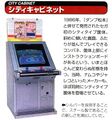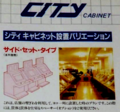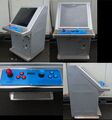Sega City: Difference between revisions
Jump to navigation
Jump to search
No edit summary |
|||
| Line 41: | Line 41: | ||
Image:SEGA Time Scanner ad (alternate, panel closeup).jpg|SEGA ''Time Scanner'' ad (pinball panel closeup) | Image:SEGA Time Scanner ad (alternate, panel closeup).jpg|SEGA ''Time Scanner'' ad (pinball panel closeup) | ||
Image:SEGA Time Scanner pinball panel on City & T-13.jpg|SEGA Time Scanner pinball panel on City & T-13 | Image:SEGA Time Scanner pinball panel on City & T-13.jpg|SEGA Time Scanner pinball panel on City & T-13 | ||
Image:SEGA Arcade History GAME CARD reader on CITY cab.jpg|SEGA City special control panel with ''Game Card'' reader | |||
Image:SEGA_prepaid_magnetic_''game_card''_reader_in_CITY_18_cabinet.jpg|SEGA ''Game Card'' reader on CITY 18 cab | Image:SEGA_prepaid_magnetic_''game_card''_reader_in_CITY_18_cabinet.jpg|SEGA ''Game Card'' reader on CITY 18 cab | ||
Image:SEGA game card system diagram.jpg|SEGA ''Game Card'' system on CITY & T-13 cabs | Image:SEGA game card system diagram.jpg|SEGA ''Game Card'' system on CITY & T-13 cabs | ||
Revision as of 17:38, 5 April 2024
Released for the first time in 1986 in Japan with the game Dump Matsumoto (ダンプ松本 aka Body Slam, see article below). A special version of the cabinet was released with a prepaid magnetic card reader (SEGA "Game Card") which SEGA themselves state was similar to TAITO's own We'll Talk card system.
Gallery
-
SEGA Arcade History profile for CITY cabinet
-
compatible with Sega T-13 panel
-
japanese flyer
-
City sitdown converted to upright
-
City 18 cab & custom panel for SEGA Action Fighter(1986)
-
City 18 & Afterburner conversion kit
-
Time Scanner pinball panel kit on City 18
-
SEGA Time Scanner ad (pinball panel closeup)
-
SEGA Time Scanner pinball panel on City & T-13
-
SEGA City special control panel with Game Card reader
-
SEGA Game Card reader on CITY 18 cab
-
SEGA Game Card system on CITY & T-13 cabs


















